Identification of Bird Habitat Restoration Priorities in a Central Area of a Megacity
Abstract
:1. Introduction
2. Study Area and Data Pre-Processing
2.1. Study Area
2.2. Bird Records
2.3. Environmental Predictors
3. Methods
3.1. Research Framework
3.2. Prediction of Bird Distribution
3.3. Identification of Hotspot and Coldspot Areas
3.4. Assessment of Habitat Quality
3.5. Priority Identification of Habitat Restoration for Birds
4. Results
4.1. Potential Species Richness Patterns and the Importance of Environmental Factors
4.2. Spatial Pattern of Bird Hotspots
4.3. Evaluation and Spatial Distribution of Habitat Quality
4.4. Spatial Matching Types of Bird Richness and Habitat Quality
5. Discussion
5.1. Environmental Drivers of Bird Distribution
5.2. Implications for Bird Habitat Restoration
5.3. Research Limitations
6. Conclusions
Supplementary Materials
Author Contributions
Funding
Data Availability Statement
Acknowledgments
Conflicts of Interest
Appendix A. Environmental Factors Used in RF Model
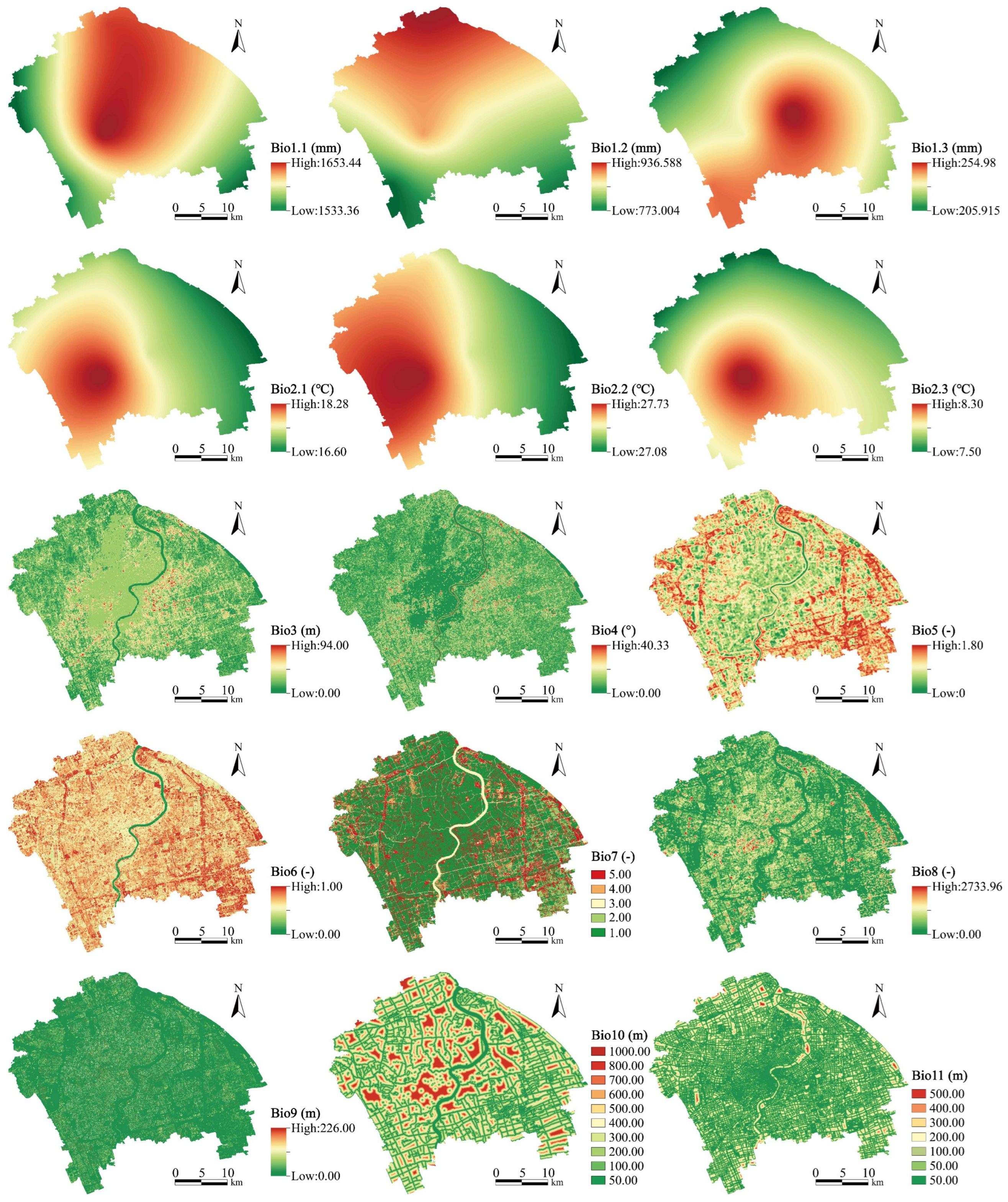
Appendix B. The Spatial Distribution of the Probability of Occurrence for Individual Species
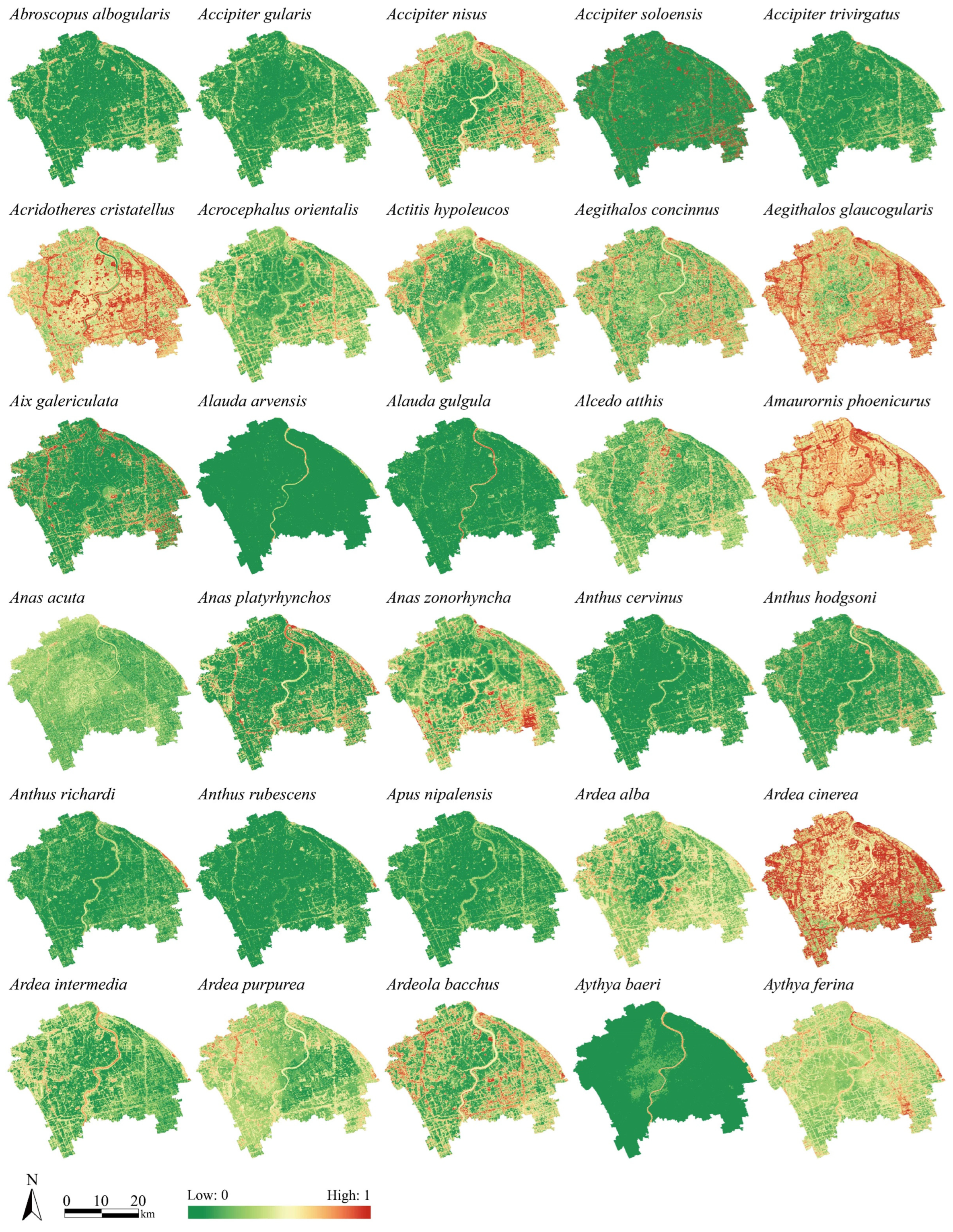


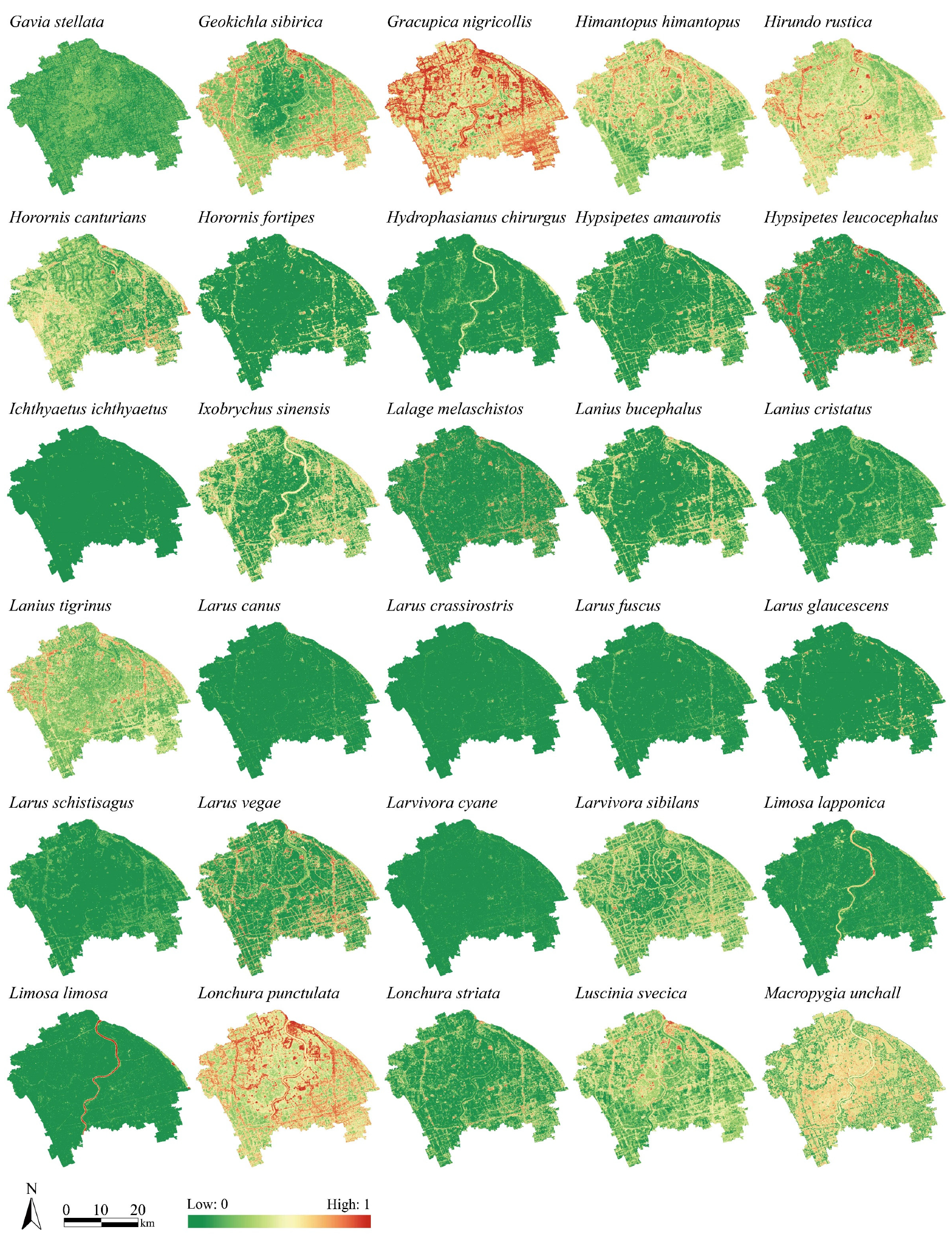
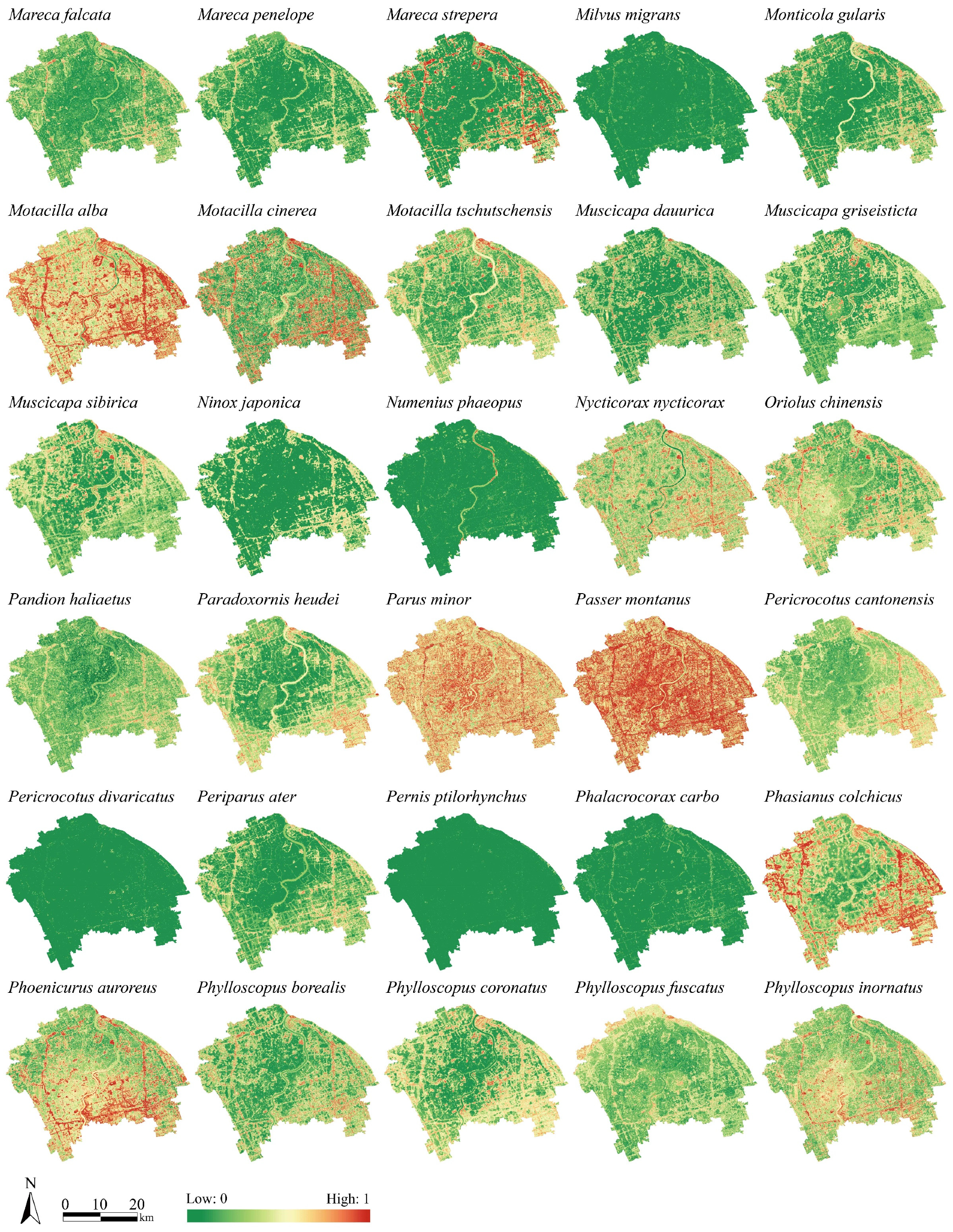

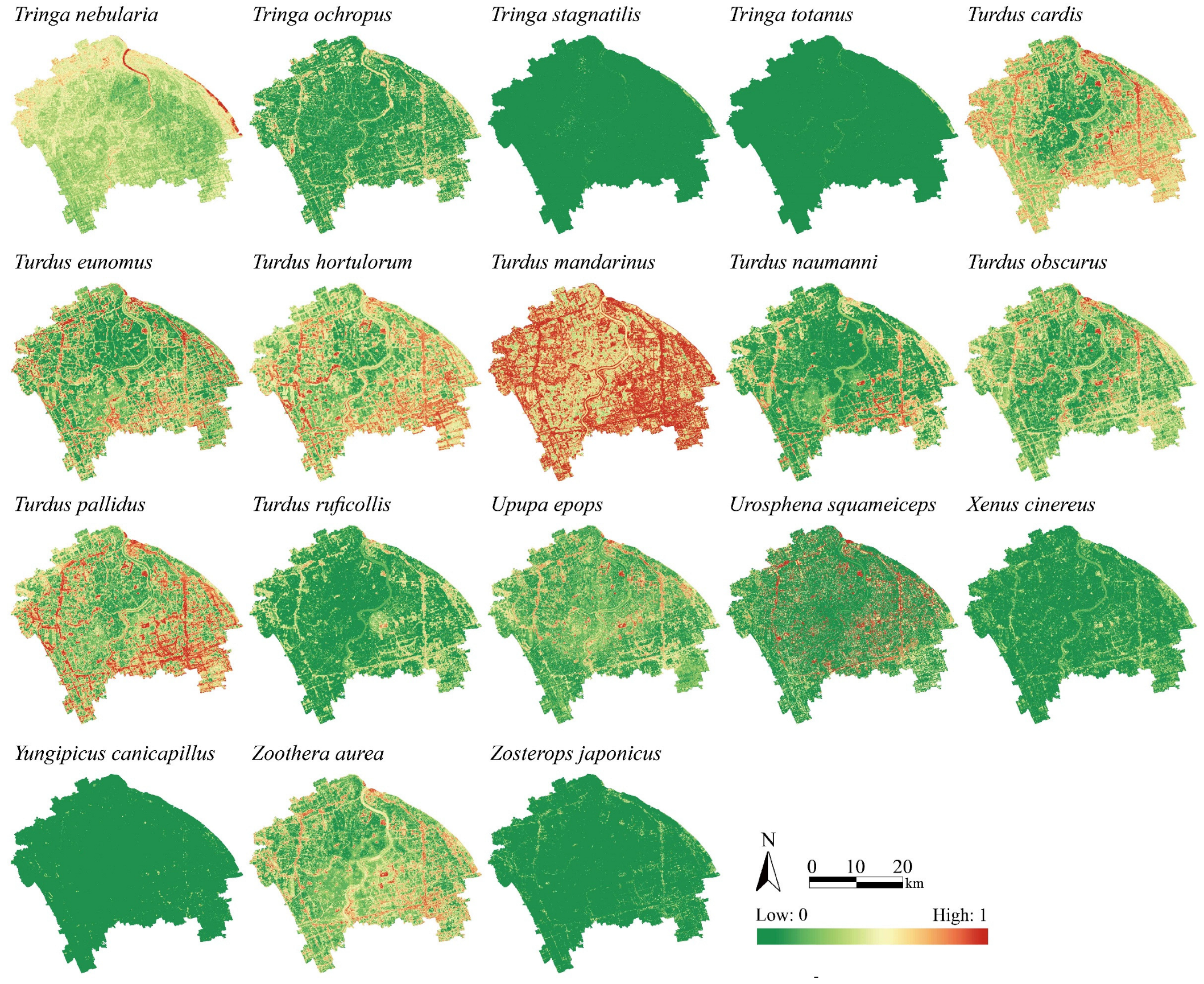
References
- Institute, W.R. Ecosystems and Human Well-Being: Biodiversity Synthesis; World Resources Institute: Washington, DC, USA, 2005. [Google Scholar]
- Mandle, L.; Wolny, S.; Bhagabati, N.; Helsingen, H.; Hamel, P.; Bartlett, R.; Dixon, A.; Horton, R.; Lesk, C.; Manley, D.; et al. Assessing ecosystem service provision under climate change to support conservation and development planning in Myanmar. PLoS ONE 2017, 12, e0184951. [Google Scholar] [CrossRef] [PubMed]
- Gao, J.; O’Neill, B.C. Mapping global urban land for the 21st century with data-driven simulations and Shared Socioeconomic Pathways. Nat. Commun. 2020, 11, 2302. [Google Scholar] [CrossRef] [PubMed]
- Zhao, A.; Tian, X.; Jin, Z.; Zhang, A. The imprint of urbanization on vegetation in the ecologically fragile area: A case study from China’s Loess Plateau. Ecol. Indic. 2023, 154, 110791. [Google Scholar] [CrossRef]
- Zhou, T.; Liu, H.; Gou, P.; Xu, N. Conflict or Coordination? measuring the relationships between urbanization and vegetation cover in China. Ecol. Indic. 2023, 147, 109993. [Google Scholar] [CrossRef]
- Seto, K.C.; Guneralp, B.; Hutyra, L.R. Global forecasts of urban expansion to 2030 and direct impacts on biodiversity and carbon pools. Proc. Natl. Acad. Sci. USA 2012, 109, 16083–16088. [Google Scholar] [CrossRef]
- Hu, J.; Zhang, J.; Li, Y. Exploring the spatial and temporal driving mechanisms of landscape patterns on habitat quality in a city undergoing rapid urbanization based on GTWR and MGWR: The case of Nanjing, China. Ecol. Indic. 2022, 143, 109333. [Google Scholar] [CrossRef]
- Sazima, I.; Sazima, M. A handful of beauty and services: Flower-visiting birds at two small urbanised sites in south-eastern Brazil and Australia. Flora 2022, 296, 152151. [Google Scholar] [CrossRef]
- Jahani, A.; Kalantary, S.; Alitavoli, A. An application of artificial intelligence techniques in prediction of birds soundscape impact on tourists’ mental restoration in natural urban areas. Urban For. Urban Green. 2021, 61, 127088. [Google Scholar] [CrossRef]
- Cox, D.T.C.; Hudson, H.L.; Plummer, K.E.; Siriwardena, G.M.; Anderson, K.; Hancock, S.; Devine-Wright, P.; Gaston, K.J.; MacIvor, J.S. Covariation in urban birds providing cultural services or disservices and people. J. Appl. Ecol. 2018, 55, 2308–2319. [Google Scholar] [CrossRef]
- Strohbach, M.W.; Lerman, S.B.; Warren, P.S. Are small greening areas enhancing bird diversity? Insights from community-driven greening projects in Boston. Landsc. Urban Plan. 2013, 114, 69–79. [Google Scholar] [CrossRef]
- Liordos, V.; Jokimaki, J.; Kaisanlahti-Jokimaki, M.L.; Valsamidis, E.; Kontsiotis, V.J. Patch, matrix and disturbance variables negatively influence bird community structure in small-sized managed green spaces located in urban core areas. Sci. Total Environ. 2021, 801, 149617. [Google Scholar] [CrossRef] [PubMed]
- Adams, C.A.; Fernández-Juricic, E.; Bayne, E.M.; St. Clair, C.C. Effects of artificial light on bird movement and distribution: A systematic map. Environ. Evid. 2021, 10, 37. [Google Scholar] [CrossRef]
- Myers, N.; Mittermeier, R.A.; Mittermeier, C.G.; Fonseca, G.A.B.d.; Kent, J. Biodiversity hotspots for conservation priorities. Nature 2000, 403, 853–858. [Google Scholar] [CrossRef] [PubMed]
- Liu, T.; Liu, H.; Yang, Y. Uncovering the determinants of biodiversity hotspots in China: Evidence from the drivers of multiple diversity metrics on insect assemblages and implications for conservation. Sci. Total Environ. 2023, 880, 163287. [Google Scholar] [CrossRef]
- Hu, R.; Wen, C.; Gu, Y.; Wang, H.; Gu, L.; Shi, X.; Zhong, J.; Wei, M.; He, F.; Lu, Z. A bird’s view of new conservation hotspots in China. Biol. Conserv. 2017, 211, 47–55. [Google Scholar] [CrossRef]
- Arcos, J.M.; Bécares, J.; Villero, D.; Brotons, L.; Rodríguez, B.; Ruiz, A. Assessing the location and stability of foraging hotspots for pelagic seabirds: An approach to identify marine Important Bird Areas (IBAs) in Spain. Biol. Conserv. 2012, 156, 30–42. [Google Scholar] [CrossRef]
- Ganatsas, P.; Tsakaldimi, M.; Oikonomakis, N.; Davis, M.; Manios, C.; Broumpas, C. Reduction, degradation and restoration of Salix alba habitat in the Kerkini National Park, northern Greece; an important habitat for endangered bird species. Ecol. Eng. 2022, 179, 106593. [Google Scholar] [CrossRef]
- Wang, G.; Wu, H.; Dai, J.; Xiong, Y.; Long, Y.; Cai, X.; Mo, S.; Yang, R.; Liu, Y. Priorities identification of habitat restoration for migratory birds under the increased water level during the middle of dry season: A case study of Poyang Lake and Dongting Lake wetlands, China. Ecol. Indic. 2023, 151, 110322. [Google Scholar] [CrossRef]
- Ferrarini, A.; Celada, C.; Gustin, M. Preserving the Mediterranean bird flyways: Assessment and prioritization of 38 main wetlands under human and climate threats in Sardinia and Sicily (Italy). Sci. Total Environ. 2021, 751, 141556. [Google Scholar] [CrossRef]
- Gonzalez, A.M.; Espejo, N.; Armenteras, D.; Hobson, K.A.; Kardynal, K.J.; Mitchell, G.W.; Mahony, N.; Bishop, C.A.; Negret, P.J.; Wilson, S. Habitat protection and restoration: Win–win opportunities for migratory birds in the Northern Andes. Perspect. Ecol. Conserv. 2023, 21, 33–40. [Google Scholar] [CrossRef]
- Guisan, A.; Zimmermann, N.E. Predictive habitat distribution models in ecology. Ecol. Model. 2000, 135, 147–186. [Google Scholar] [CrossRef]
- Elith, J.; Leathwick, J.R. Species Distribution Models: Ecological Explanation and Prediction Across Space and Time. Annu. Rev. Ecol. Evol. Syst. 2009, 40, 677–697. [Google Scholar] [CrossRef]
- Phillips, S.J.; Anderson, R.P.; Schapire, R.E. Maximum entropy modeling of species geographic distributions. Ecol. Model. 2006, 190, 231–259. [Google Scholar] [CrossRef]
- Xie, S.; Wang, X.; Zhou, W.; Wu, T.; Qian, Y.; Lu, F.; Gong, C.; Zhao, H.; Ouyang, Z. The effects of residential greenspace on avian Biodiversity in Beijing. Glob. Ecol. Conserv. 2020, 24, e01223. [Google Scholar] [CrossRef]
- Morelli, F.; Benedetti, Y.; Su, T.; Zhou, B.; Moravec, D.; Šímová, P.; Liang, W. Taxonomic diversity, functional diversity and evolutionary uniqueness in bird communities of Beijing’s urban parks: Effects of land use and vegetation structure. Urban For. Urban Green. 2017, 23, 84–92. [Google Scholar] [CrossRef]
- La Sorte, F.A.; Lepczyk, C.A.; Burnett, J.L.; Hurlbert, A.H.; Tingley, M.W.; Zuckerberg, B. Opportunities and challenges for big data ornithology. Condor 2018, 120, 414–426. [Google Scholar] [CrossRef]
- Sullivan, B.L.; Aycrigg, J.L.; Barry, J.H.; Bonney, R.E.; Bruns, N.; Cooper, C.B.; Damoulas, T.; Dhondt, A.A.; Dietterich, T.; Farnsworth, A.; et al. The eBird enterprise: An integrated approach to development and application of citizen science. Biol. Conserv. 2014, 169, 31–40. [Google Scholar] [CrossRef]
- Squires, T.M.; Yuda, P.; Akbar, P.G.; Collar, N.J.; Devenish, C.; Taufiqurrahman, I.; Wibowo, W.K.; Winarni, N.L.; Yanuar, A.; Marsden, S.J. Citizen science rapidly delivers extensive distribution data for birds in a key tropical biodiversity area. Glob. Ecol. Conserv. 2021, 28, e01680. [Google Scholar] [CrossRef]
- Liu, Z.; Zhou, Y.; Yang, H.; Liu, Z. Urban green infrastructure affects bird biodiversity in the coastal megalopolis region of Shenzhen city. Appl. Geogr. 2023, 151, 102860. [Google Scholar] [CrossRef]
- Wong, J.S.Y.; Soh, M.C.K.; Low, B.W.; Er, K.B.H. Tropical bird communities benefit from regular-shaped and naturalised urban green spaces with water bodies. Landsc. Urban Plan. 2023, 231, 104644. [Google Scholar] [CrossRef]
- Dai, S.; Feng, D.; Xu, B. Monitoring potential geographical distribution of four wild bird species in China. Environ. Earth Sci. 2016, 75, 790. [Google Scholar] [CrossRef]
- Robinson, O.J.; Ruiz-Gutierrez, V.; Reynolds, M.D.; Golet, G.H.; Strimas-Mackey, M.; Fink, D.; Maiorano, L. Integrating citizen science data with expert surveys increases accuracy and spatial extent of species distribution models. Divers. Distrib. 2020, 26, 976–986. [Google Scholar] [CrossRef]
- Arenas-Castro, S.; Regos, A.; Martins, I.; Honrado, J.; Alonso, J. Effects of input data sources on species distribution model predictions across species with different distributional ranges. J. Biogeogr. 2022, 49, 1299–1312. [Google Scholar] [CrossRef]
- Yang, G.; Xu, J.; Wang, Y.; Wang, X.; Pei, E.; Yuan, X.; Li, H.; Ding, Y.; Wang, Z. Evaluation of microhabitats for wild birds in a Shanghai urban area park. Urban For. Urban Green. 2015, 14, 246–254. [Google Scholar] [CrossRef]
- Guangmei, Z. A Checklist on the Classification and Distribution of the Birds of China, 3rd ed.; Science Press: Beijing, China, 2017; ISBN 978-7-03-054751-4. [Google Scholar]
- Shanghai Wild Bird Society. 2019 Shanghai Bird List; Shanghai Wild Bird Society: Shanghai, China, 2020. [Google Scholar]
- Nava-Díaz, R.; Pineda-López, R.; Dorantes-Euan, A. Drivers of Functional Composition of Bird Assemblages in Green Spaces of a Neotropical City: A Case Study From Merida, Mexico. Trop. Conserv. Sci. 2020, 13. [Google Scholar] [CrossRef]
- Zhao, Z.; Xiao, N.; Shen, M.; Li, J. Comparison between optimized MaxEnt and random forest modeling in predicting potential distribution: A case study with Quasipaa boulengeri in China. Sci. Total Environ. 2022, 842, 156867. [Google Scholar] [CrossRef]
- Belhaj, A.; Pallarés, S.; Bennas, N.; Chergui, B.; Sánchez-Fernández, D. Towards the identification of hotspots of freshwater biodiversity in North-Western Africa: A case study using species distribution models for water beetles in Morocco. Glob. Ecol. Conserv. 2023, 43, e02441. [Google Scholar] [CrossRef]
- Wei, T.; Simko, V. R Package ‘Corrplot’: Visualization of a Correlation Matrix (Version 0.92). Available online: https://github.com/taiyun/corrplot (accessed on 29 April 2023).
- Yang, C.; Zhao, S. A building height dataset across China in 2017 estimated by the spatially-informed approach. Sci. Data 2022, 9, 76. [Google Scholar] [CrossRef]
- Sharp, R.; Tallis, H.T.; Ricketts, T.; Guerry, A.D.; Wood, S.A.; Chaplin-Kramer, R.; Nelson, E.; Ennaanay, D.; Wolny, S.; Olwero, N.; et al. VEST 3.7.0.post22+ug.h3b687e57fad0 User’s Guide. The Natural Capital Project, Stanford University, University of Minnesota, The Nature Conservancy, and World Wildlife Fund. 2018. Available online: https://www.fundacioncanal.com/wp-content/uploads/2022/04/Adaptacion_CC_Fundacion-Canal_eng_2022.pdf (accessed on 18 July 2023).
- Mi, C.; Huettmann, F.; Guo, Y.; Han, X.; Wen, L. Why choose Random Forest to predict rare species distribution with few samples in large undersampled areas? Three Asian crane species models provide supporting evidence. PeerJ 2017, 5, e2849. [Google Scholar] [CrossRef]
- Moreno, R.; Zamora, R.; Molina, J.R.; Vasquez, A.; Herrera, M.Á. Predictive modeling of microhabitats for endemic birds in South Chilean temperate forests using Maximum entropy (Maxent). Ecol. Inform. 2011, 6, 364–370. [Google Scholar] [CrossRef]
- Wang, G.; Wang, C.; Guo, Z.; Dai, L.; Wu, Y.; Liu, H.; Li, Y.; Chen, H.; Zhang, Y.; Zhao, Y.; et al. Integrating Maxent model and landscape ecology theory for studying spatiotemporal dynamics of habitat: Suggestions for conservation of endangered Red-crowned crane. Ecol. Indic. 2020, 116, 106472. [Google Scholar] [CrossRef]
- Liang, J.; Peng, Y.; Zhu, Z.; Li, X.; Xing, W.; Li, X.; Yan, M.; Yuan, Y. Impacts of changing climate on the distribution of migratory birds in China: Habitat change and population centroid shift. Ecol. Indic. 2021, 127, 107729. [Google Scholar] [CrossRef]
- Liaw, A.; Wiener, M. Classification and Regression by randomForest. R News 2002, 2, 18–22. [Google Scholar]
- Anselin, L.; Syabri, I.; Kho, Y. GeoDa: An Introduction to Spatial Data Analysis. In Handbook of Applied Spatial Analysis: Software Tools, Methods and Applications; Fischer, M.M., Getis, A., Eds.; Springer: Berlin, Heidelberg, 2010; pp. 73–89. [Google Scholar]
- Anselin, L. Local Indicators of Spatial Association—LISA. Geogr. Anal. 1995, 27, 93–115. [Google Scholar] [CrossRef]
- Zhu, C.; Zhang, X.; Zhou, M.; He, S.; Gan, M.; Yang, L.; Wang, K. Impacts of urbanization and landscape pattern on habitat quality using OLS and GWR models in Hangzhou, China. Ecol. Indic. 2020, 117, 106654. [Google Scholar] [CrossRef]
- Nie, C.; Yang, J.; Huang, C. Assessing the Habitat Quality of Aquatic Environments in Urban Beijing. Procedia Environ. Sci. 2016, 36, 162–168. [Google Scholar] [CrossRef]
- Zhou, L.; Zhang, H.; Bi, G.; Su, K.; Wang, L.; Chen, H.; Yang, Q. Multiscale perspective research on the evolution characteristics of the ecosystem services supply-demand relationship in the chongqing section of the three gorges reservoir area. Ecol. Indic. 2022, 142, 109227. [Google Scholar] [CrossRef]
- Ding, T.; Chen, J.; Fang, L.; Ji, J.; Fang, Z. Urban ecosystem services supply-demand assessment from the perspective of the water-energy-food nexus. Sustain. Cities Soc. 2023, 90, 104401. [Google Scholar] [CrossRef]
- Nieto, S.; Flombaum, P.; Garbulsky, M.F. Can temporal and spatial NDVI predict regional bird-species richness? Glob. Ecol. Conserv. 2015, 3, 729–735. [Google Scholar] [CrossRef]
- Bonthoux, S.; Lefèvre, S.; Herrault, P.-A.; Sheeren, D. Spatial and Temporal Dependency of NDVI Satellite Imagery in Predicting Bird Diversity over France. Remote Sens. 2018, 10, 1136. [Google Scholar] [CrossRef]
- Matthies, S.A.; Rüter, S.; Schaarschmidt, F.; Prasse, R. Determinants of species richness within and across taxonomic groups in urban green spaces. Urban Ecosyst. 2017, 20, 897–909. [Google Scholar] [CrossRef]
- Callaghan, C.T.; Bino, G.; Major, R.E.; Martin, J.M.; Lyons, M.B.; Kingsford, R.T. Heterogeneous urban green areas are bird diversity hotspots: Insights using continental-scale citizen science data. Landsc. Ecol. 2019, 34, 1231–1246. [Google Scholar] [CrossRef]
- Amaya-Espinel, J.D.; Hostetler, M.; Henríquez, C.; Bonacic, C. The influence of building density on Neotropical bird communities found in small urban parks. Landsc. Urban Plan. 2019, 190, 103578. [Google Scholar] [CrossRef]
- De Camargo, R.X.; Boucher-Lalonde, V.; Currie, D.J.; Zurell, D. At the landscape level, birds respond strongly to habitat amount but weakly to fragmentation. Divers. Distrib. 2018, 24, 629–639. [Google Scholar] [CrossRef]
- Fernández-Juricic, E.; Jokimäki, J. A Habitat Island Approach to Conserving Birds in Urban Landscapes: Case Studies from Southern and Northern Europe. Biodivers. Conserv. 2001, 10, 2023–2043. [Google Scholar] [CrossRef]
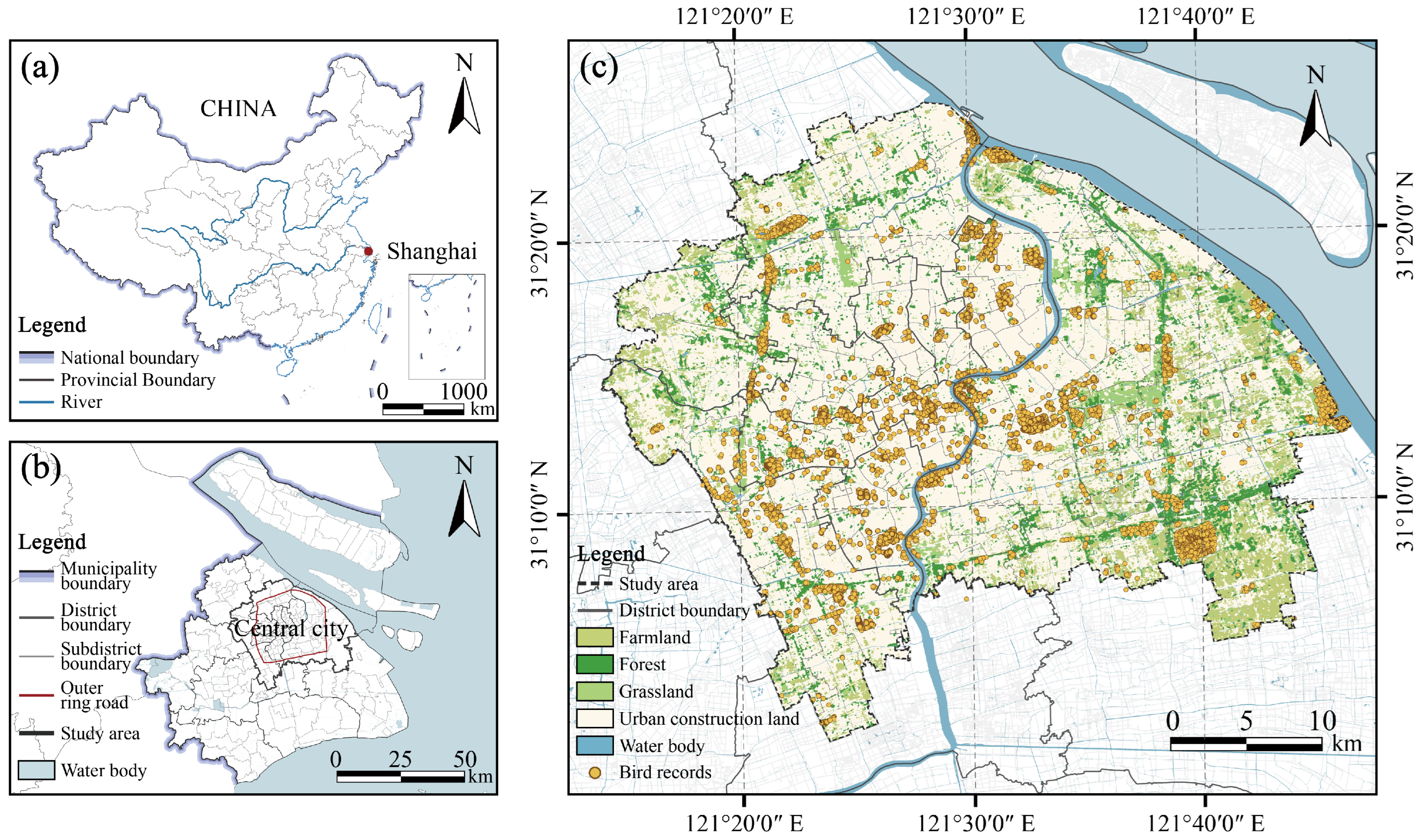



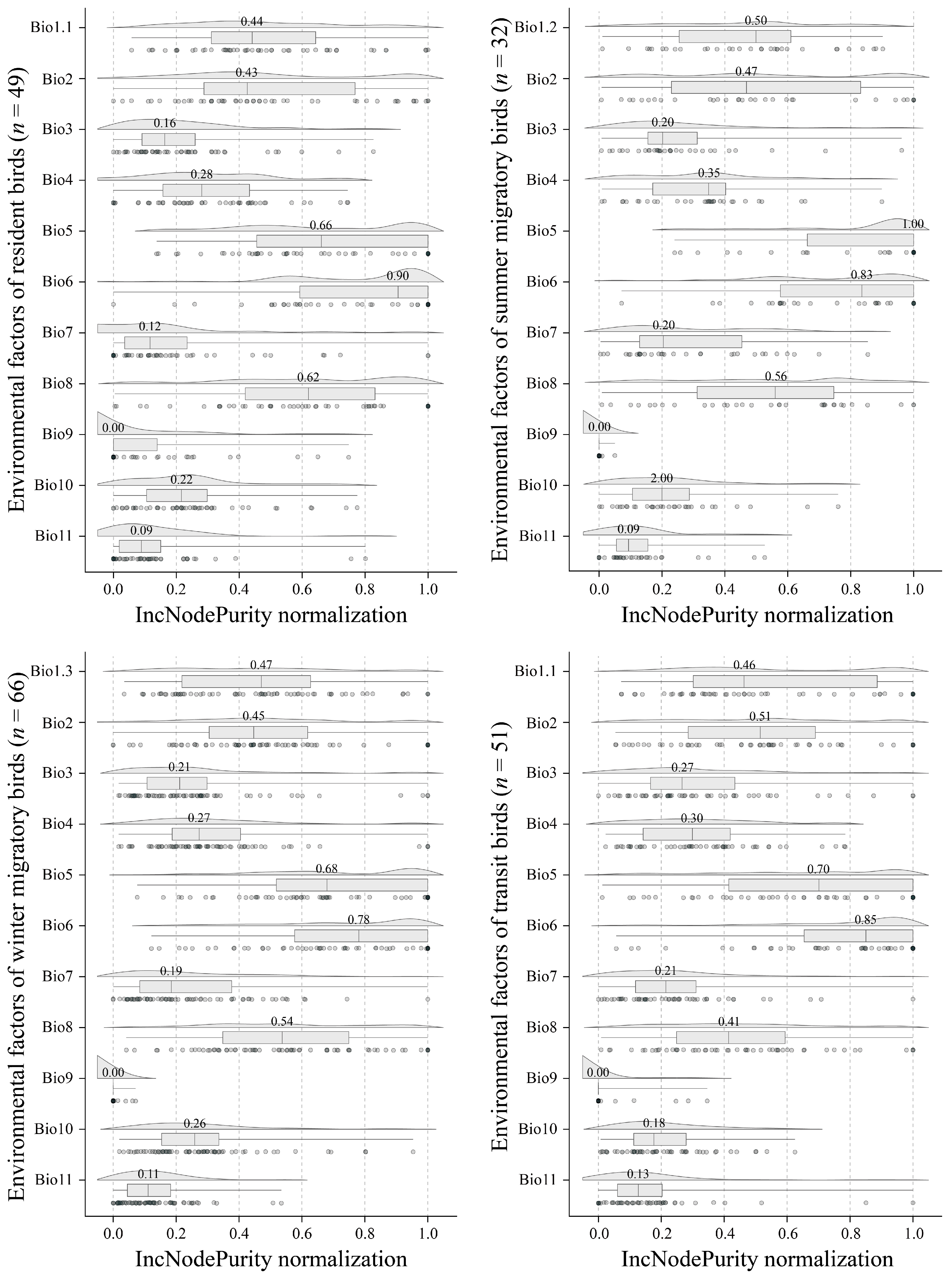
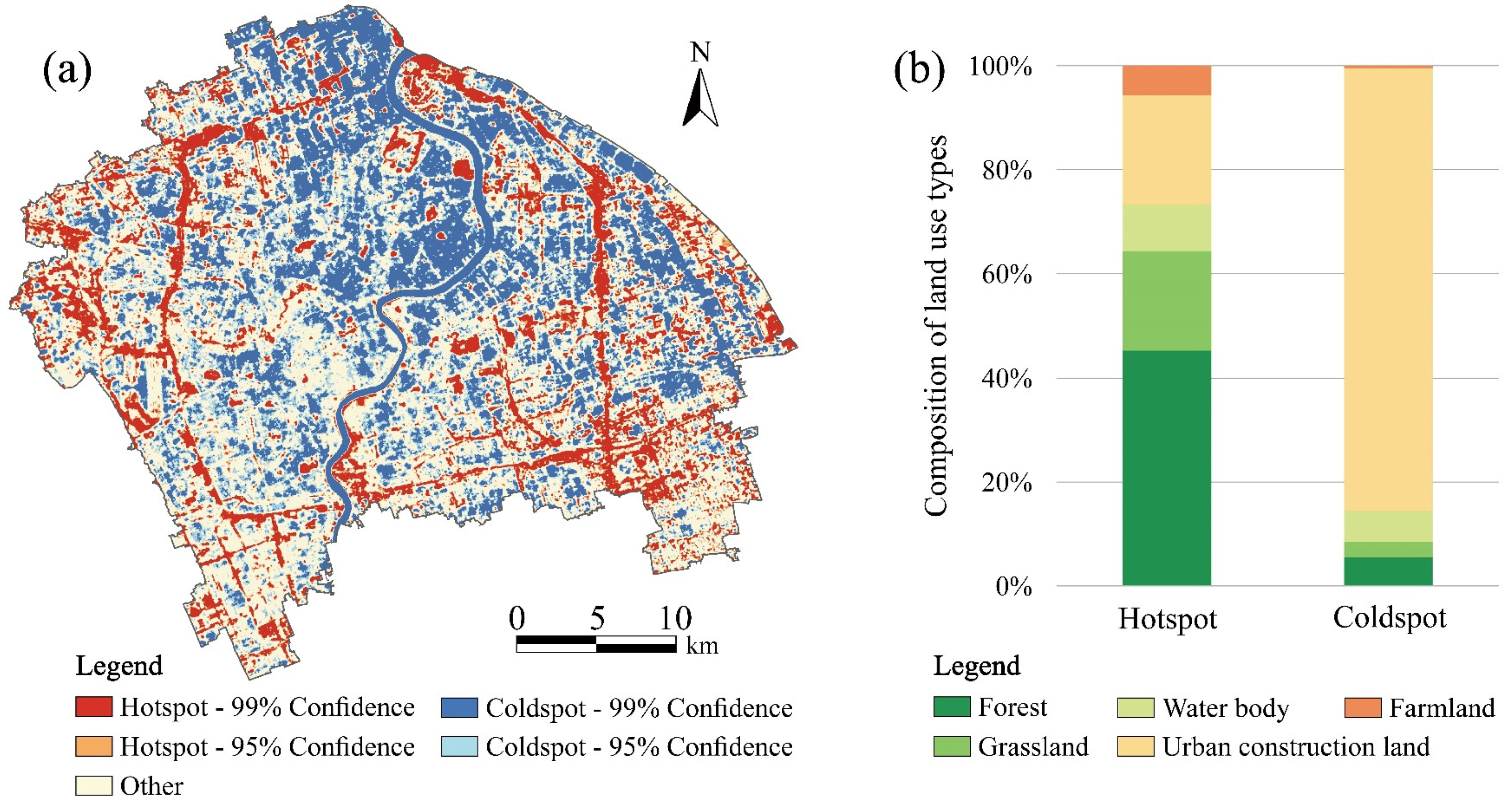



| Phenological Status | Definition |
|---|---|
| Resident birds | Birds that reside year-round within their habitat are collectively referred to as resident birds. |
| Summer migratory birds | Migratory birds that breed in a specific region during summer, migrate to warmer southern regions for winter, and return to the same region for breeding the following spring are referred to as summer migratory birds in that particular area. |
| Winter migratory birds | Birds that winter in a specific region, fly north for breeding in the following spring, and return to the same region for wintering in the autumn are referred to as winter migratory birds in that particular area. |
| Transient birds | Birds that pass through a specific area during migration but do not breed or winter in that area are referred to as transient birds in that particular region. |
| Factor Type | Factor Name | Unit | Source | |
|---|---|---|---|---|
| Climate | Bio1 Precipitation | Bio1.1 Annual cumulative precipitation | mm | Calculated using Kriging from spatial analyst tools in ArcGIS 10.8 based on data from https://data.cma.cn/ (accessed on 25 April 2023) |
| Bio1.2 Summer cumulative precipitation | mm | |||
| Bio1.3 Winter cumulative precipitation | mm | |||
| Bio2 Temperature | Bio2.1 Annual mean temperature | ℃ | Calculated using Kriging from spatial analyst tools in ArcGIS 10.8 based on data from https://data.cma.cn/ (accessed on 25 April 2023) | |
| Bio2.2 Summer mean temperature | ℃ | |||
| Bio2.3 Winter mean temperature | ℃ | |||
| Topography | Bio3 Elevation | m | https://www.gscloud.cn/ (accessed on 23 April 2023) | |
| Bio4 Slope | ° | Calculated using slope from spatial analyst tools in ArcGIS 10.8 based on DEM data | ||
| Landscape pattern | Bio5 Landscape Shannon’s Diversity Index (SHDI) | - | Calculated using Fragstats 4.2 based on land use data | |
| Vegetation | Bio6 Normalized Difference Vegetation Index (NDVI) | - | Calculated using ENVI 5.4 based on Landsat 8 OLI TIRS data from https://www.gscloud.cn/ (accessed on 23 April 2023) | |
| Built environment | Bio7 Land use | - | Calculated using ENVI 5.4 based on Landsat 8 OLI TIRS data from https://www.gscloud.cn/ (accessed on 23 April 2023) | |
| Bio8 Building density | - | Calculated using KernelDensity from spatial analyst tools in ArcGIS 10.8 based on building data | ||
| Bio9 Building height | m | From the literature [42] | ||
| Bio10 Distance to water body | m | Calculated using MultipleRingBuffer from analysis tools in ArcGIS 10.8 based on water data | ||
| Bio11 Distance to roads | m | Calculated using MultipleRingBuffer from analysis tools in ArcGIS 10.8 based on road data | ||
| Bio12 Artificial night-time light | - | https://poles.tpdc.ac.cn/zh-hans/data/e755f1ba-9cd1-4e43-98ca-cd081b5a0b3e/ (accessed on 24 April 2023) | ||
| Threat | Max Distance (km) | Weight | Decay |
|---|---|---|---|
| Farmland | 1.00 | 0.30 | Exponential |
| Urban construction land | 12.0 | 1.00 | Exponential |
| Building | 7.00 | 0.80 | Linear |
| Road | 5.00 | 0.60 | Linear |
| Land Use | Habitat | Threat Factors | |||
|---|---|---|---|---|---|
| Farmland | Urban Construction Land | Building | Road | ||
| Forest | 1.30 | 0.30 | 0.70 | 0.80 | 0.60 |
| Grassland | 0.50 | 0.20 | 0.70 | 0.65 | 0.30 |
| Water body | 1.00 | 0.30 | 0.80 | 0.85 | 0.40 |
| Urban construction land | 0.00 | 0.00 | 0.00 | 0.00 | 0.00 |
| Farmland | 0.30 | 0.00 | 0.60 | 0.70 | 0.20 |
| Spatial Type | Land Use Area (km2) | Average of Bird Richness | Average of Habitat Quality | |||||
|---|---|---|---|---|---|---|---|---|
| Forest | Grassland | Water Body | Urban Construction Land | Farmland | Total | |||
| HBR-HHQ | 64.66 | 1.55 | 7.04 | 0.00 | 0.00 | 73.25 | 94.74 (1.05 *) | 0.57 (0.83 *) |
| HBR-LHQ | 2.33 | 17.67 | 0.22 | 10.60 | 3.85 | 34.68 | 86.90 (0.72 *) | 0.21 (−0.69 *) |
| LBR-HHQ | 42.67 | 1.69 | 14.19 | 0.00 | 0.00 | 58.56 | 53.25 (−0.67 *) | 0.56 (0.77 *) |
| LBR-LHQ | 2.64 | 26.56 | 0.72 | 41.76 | 10.12 | 81.80 | 50.82 (−0.77 *) | 0.14 (−0.99 *) |
Disclaimer/Publisher’s Note: The statements, opinions and data contained in all publications are solely those of the individual author(s) and contributor(s) and not of MDPI and/or the editor(s). MDPI and/or the editor(s) disclaim responsibility for any injury to people or property resulting from any ideas, methods, instructions or products referred to in the content. |
© 2023 by the authors. Licensee MDPI, Basel, Switzerland. This article is an open access article distributed under the terms and conditions of the Creative Commons Attribution (CC BY) license (https://creativecommons.org/licenses/by/4.0/).
Share and Cite
Wang, Y.; Lu, X.; Wang, R.; Jia, Y.; Huang, J. Identification of Bird Habitat Restoration Priorities in a Central Area of a Megacity. Forests 2023, 14, 1689. https://doi.org/10.3390/f14081689
Wang Y, Lu X, Wang R, Jia Y, Huang J. Identification of Bird Habitat Restoration Priorities in a Central Area of a Megacity. Forests. 2023; 14(8):1689. https://doi.org/10.3390/f14081689
Chicago/Turabian StyleWang, Yuncai, Xinghao Lu, Ruojing Wang, Yifei Jia, and Junda Huang. 2023. "Identification of Bird Habitat Restoration Priorities in a Central Area of a Megacity" Forests 14, no. 8: 1689. https://doi.org/10.3390/f14081689
APA StyleWang, Y., Lu, X., Wang, R., Jia, Y., & Huang, J. (2023). Identification of Bird Habitat Restoration Priorities in a Central Area of a Megacity. Forests, 14(8), 1689. https://doi.org/10.3390/f14081689







